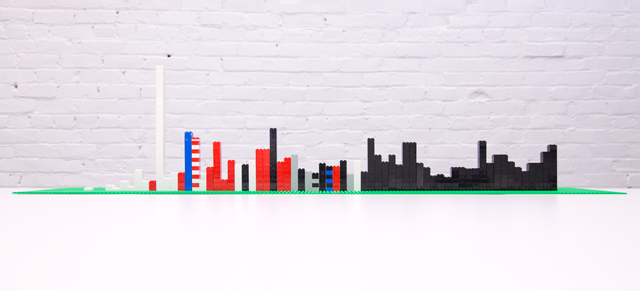Since my first post on LEGO as a Metaphor for Software Reuse, I have done some more homework on existing analyses of LEGO® products, to understand what I could myself reuse and what gaps I could fill with further data analysis.
I’ve found three fascinating analyses that I share below. However, I should note that these analyses weren’t performed considering LEGO products as a metaphor or benchmark for software reuse. So I’ve continued to ask myself: what lessons can we take away for better management of software delivery? For this post, the key takeaways are market and product drivers of variety, specialisation and complexity, rather than strategies for reuse as such. I’m hoping to share more insight on reuse in LEGO in future posts, in the context of these market and product drivers.
I also discovered the Rebrickable downloads and API, which I plan to use for any further analysis – I do hope I need to play with more data!
Reuse Concepts
I started all this thinking about software reuse, which is not an aim in itself, but a consideration and sometimes an outcome in efficiently satisfying software product objectives. As we think about reuse and consider existing analyses, I found it helpful to define a few related concepts:
- Variety – the number of different forms or properties an entity under consideration might take. We might talk about variety of themes, sets, parts, and colours, etc.
- Specialisation – of parts in particular, where parts serve only limited purposes.
- Complexity – the combinations or interactions of entities, generally increasing with increasing variety and specialisation.
- Sharing – of parts between sets in particular, where parts appear in multiple sets. We might infer specialisation from limited sharing.
- Reuse – sharing, with further consideration of time, as some reuse scenarios may be identified when a part is introduced, some may emerge over time, and some opportunities for future reuse may not be realised.
Considering these concepts, the first two analyses focus mainly on understanding variety and specialisation, while the third dives deeper into sharing and reuse.
Increase in Variety and Specialisation
The Colorful Lego
Great visualisations and analysis in this report and public dashboard from Edra Stafaj, Hyerim Hwang and Yiren Wang, driven primarily by the evolving colours found in LEGO sets of over time, and considering colour as a proxy for complexity. Some of the key findings:
- The variety of colours has increased dramatically over time, with many recently introduced colours already discontinued.
- The increase in variety of colours is connected with growth of new themes. Since 2010, there has been a marked increase in co-branded sets (“cooperative” theme, eg, Star Wars) and new in-house branded sets (“LEGO commercial” theme, eg, Ninjago) as a proportion of all sets.
- That specialised pieces (as modelled by Minifig Heads – also noted as the differentiating part between themes) make up the bulk of new pieces, compared to new generic pieces (as modelled by Bricks & Plates).
Colour is an interesting dimension to consider, as it may be argued an aesthetic, rather than mechanical, consideration for reuse. However, as noted in the diversification of themes, creating and satisfying a wider array of customer segments is connected to the increasing variety of colour.
So I see variety and complexity increasing, and more specialisation over time. The discontinuation of colours suggests reuse may be reducing over time, even while generic bricks & plates persist.
67 Years of Lego Sets

An engaging summary from Joel Carron of the evolution of LEGO sets over the years, including Python notebook code, and complete with a final visualisation made of LEGO bricks! Some highlights:
- The number of parts in a set has in general increased over time.
- The smaller sets have remained a similar size over time, but the bigger sets keep getting bigger.
- As above, colours are diversifying, with minor colours accounting for more pieces, and themes developing distinct colour palettes.
- Parts and sets can be mapped in a graph or network showing the degree to which parts are shared between sets in different themes. This shows some themes share a lot of parts with other themes, while some themes have a greater proportion of unique parts. Generally, smaller themes (with fewer total parts) share more than larger themes (with more total parts).
So here we add to variety and specialisation with learning about sharing too, but without the chronological view of that would help us understand more about reuse – were sets with high degrees of part sharing developed concurrently or sequentially?
Reduction in Sharing and Reuse
LEGO products have become more complex
A comprehensive paper, with dataset and R scripts, analysing increasing complexity in LEGO products, with a range of other interesting-looking references to follow up on, though acknowledgement that scientific investigations on the development of the LEGO products remain scarce.
This needs a thorough review in its own post, with further analysis and commentary on the implications for software reuse and management. That will be the third post of this trilogy in N parts.
Lessons for Software Reuse
If we are considering LEGO products as a metaphor and benchmark for software reuse, we should consider the following.
Varied market needs drive variety and specialisation of products, which in turn can be expected to drive variety and specialisation of software components. Reuse of components here may be counter-productive from a product-market fit perspective (alone, without further technical considerations). However, endless customisation is also problematic and a well-designed product portfolio will allow efficient service of the market.
Premium products may also be more complex, with more specialised components. Simpler products, with lesser performance requirements, may share more components. The introduction of more premium products over time may be a major driver of increased variety and specialisation.
These market and product drivers provide context for reuse of software components.
LEGO® is a trademark of the LEGO Group of companies which does not sponsor, authorize or endorse this site.
